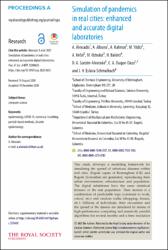| dc.contributor.author | Alexiadis, A. | |
| dc.contributor.author | Albano, A. | |
| dc.contributor.author | Rahmat, A. | |
| dc.contributor.author | Yıldız, Mehmet | |
| dc.contributor.author | Kefal, A. | |
| dc.contributor.author | Özbulut, Murat | |
| dc.date.accessioned | 2021-06-05T19:56:08Z | |
| dc.date.available | 2021-06-05T19:56:08Z | |
| dc.date.issued | 2021 | |
| dc.identifier.issn | 1364-5021 | |
| dc.identifier.issn | 1471-2946 | |
| dc.identifier.uri | https://doi.org/10.1098/rspa.2020.0653 | |
| dc.identifier.uri | https://hdl.handle.net/20.500.12960/167 | |
| dc.description | 0000-0001-9240-3517 | en_US |
| dc.description | 0000-0003-1626-5858 | en_US |
| dc.description | 0000-0001-6213-8783 | en_US |
| dc.description | PubMed: 33633493 | en_US |
| dc.description | WOS:000613719800001 | en_US |
| dc.description.abstract | This study develops a modelling framework for simulating the spread of infectious diseases within real cities. Digital copies of Birmingham (UK) and Bogota (Colombia) are generated, reproducing their urban environment, infrastructure and population. The digital inhabitants have the same statistical features of the real population. Their motion is a combination of predictable trips (commute to work, school, etc.) and random walks (shopping, leisure, etc.). Millions of individuals, their encounters and the spread of the disease are simulated by means of high-performance computing and massively parallel algorithms for several months and a time resolution of 1 minute. Simulations accurately reproduce the COVID-19 data for Birmingham and Bogota both before and during the lockdown. The model has only one adjustable parameter calculable in the early stages of the pandemic. Policymakers can use our digital cities as virtual laboratories for testing, predicting and comparing the effects of policies aimed at containing epidemics. | en_US |
| dc.description.sponsorship | Engineering and Physical Sciences Research Council (EPSRC)UK Research & Innovation (UKRI)Engineering & Physical Sciences Research Council (EPSRC) [EP/S019227/1]; EPSRCUK Research & Innovation (UKRI)Engineering & Physical Sciences Research Council (EPSRC) [EP/P020232/1] | en_US |
| dc.description.sponsorship | This work was supported by the Engineering and Physical Sciences Research Council (EPSRC) grant no. EP/S019227/1. The computations described in this paper were performed using (i) University of Birmingham's BlueBEAR HPC service and (ii) Athena at HPC Midlands+ (funded by the EPSRC with grant no. EP/P020232/1). | en_US |
| dc.language.iso | eng | en_US |
| dc.publisher | Royal Soc | en_US |
| dc.relation.ispartof | Proceedings on the Royal Society A-Mathematical Physical and Engineering Sciences | en_US |
| dc.rights | info:eu-repo/semantics/openAccess | en_US |
| dc.subject | Epidemiology | en_US |
| dc.subject | Covıd-19 | en_US |
| dc.subject | Numerical Modelling | en_US |
| dc.subject | Particle-Based Methods | en_US |
| dc.subject | Discrete Epidemiology | en_US |
| dc.title | Simulation of pandemics in real cities: enhanced and accurate digital laboratories | en_US |
| dc.type | article | en_US |
| dc.department | Denizcilik Meslek Yüksekokulu, Motorlu Araçlar ve Ulaştırma Teknolojileri Programı | en_US |
| dc.department-temp | [Alexiadis, A.; Albano, A.; Rahmat, A.; Duque-Daza, c. A.] Univ Birmingham, Sch chem Engn, Birmingham B15 2TT, W Midlands, England; [Yildiz, M.; Kefal, A.] Sabanci Univ, Fac Engn & Nat Sci, TR-34956 Istanbul, Turkey; [Ozbulut, Murat] Piri Reis Univ, Fac Engn, TR-34940 Istanbul, Turkey; [Bakirci, N.] Acibadem Univ, Sch Med, Kayisdagi 32, TR-34684 Istanbul, Turkey; [Garzon-Alvarado, D. A.; Duque-Daza, c. A.] Univ Nacl colombia, Dept Mech & Mechatron Engn, cra 30 45-03, Bogota, colombia; [Eslava-Schmalbach, J. H.] Univ Nacl colombia, Hosp Univ Nacl colombia, Sch Med, cra 30 45-03, Bogota, colombia | en_US |
| dc.contributor.institutionauthor | Özbulut, Murat | |
| dc.identifier.doi | 10.1098/rspa.2020.0653 | |
| dc.identifier.volume | 477 | en_US |
| dc.identifier.issue | 2245 | en_US |
| dc.relation.publicationcategory | Makale - Uluslararası Hakemli Dergi - Kurum Öğretim Elemanı | en_US |

















